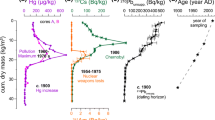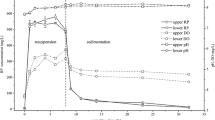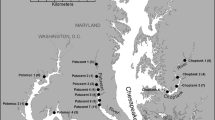Abstract
The seasonal course of phosphorus (P) fractions of sinking particulate matter has been studied at the deepest location of dimictic eutrophic Lake Scharmützel (29.5 m) by paired sediment traps at 9 and 27 m water depth from May 1996 to December 1997. Relatively large depositional fluxes and considerably variable P fluxes, mainly carried by allochthonous particles, diatoms in spring, and iron during overturns transport almost 60% of the average water column P pool to the sediment surface. The contribution of resuspension and sediment focusing (24–34%) is relatively small. A sequential chemical P extraction of the matter entrapped revealed that ,loosely adsorbed` P contributed to 5–14%, organic bound P to 55–68%, and Ca-associated P to 3–6% of the annual P flux, depending on season and depth. The redox-sensitive (iron bound) P ranged from only 12% of the annual P flux during anoxic sulfidic conditions to 28% during oxic conditions. On an annual basis, 16–18% of sedimenting P was recycled within the water column, and 71–75% of total primary P flux was recycled at the sediment surface. Ultimately, 10–23% of P became incorporated into recent sediments indicating the long residence time for P and a high internal resupply of P for primary production.
Similar content being viewed by others
References
Bloesch, J. & N.M. Burns, 1980. A critical review of sedimentation trap technique. Schweiz. Z. Hydrol. 42: 15–55.
Bloesch, J., P. Stadelmann & H. Bührer, 1977. Primary production, mineralization and sedimentation in the euphotic zone of two Swiss lakes. Limnol. Oceanogr. 22: 511–526.
Buffle, J., R. R. de Vitre, D. Perret & G. G. Leppard, 1989. Physico-chemical characteristics of a colloidal iron phosphate species formed at the oxix-anoxic interface of a eutrophic lake.-Geochim. Cosmochim. Acta 53: 399–408.
Canfield, D. E., J. R. Jones & R. W. Bachmann, 1982. Sedimentary losses of phosphorus in some natural and artificial Iowa lakes. Hydrobiologia 87: 65–76.
Currie, D. J. & J. Kalff, 1984. The relative importance of bacterioplankton and phytoplankton in phosphorus uptake in freshwater. Limnol. Oceanogr. 29: 311–321.
Eadie, B. J., R. L. Chambers, W. S. Gardner & G. L. Bell, 1984. Sediment trap studies in Lake Michigan: resuspension and chemical fluxes in the southern basin. J. Great Lakes Res. 10: 307–321.
Forsgren, G. & M. Jansson, 1993. Sedimentation of phosphorus in limnetic and estuarine environments in the River Ore system, northern Sweden. Hydrobiologia 253: 233–248.
Gächter, R. & A. Mares, 1985. Does settling seston release soluble reactive phosphorus in the hypolimnion of lakes? Limnol. Oceanogr. 30: 366–373.
Gächter, R., A. Tessier, E. Szabo & R. Carignan, 1992. Measurements of total dissolved phosphorus in small volumes of iron rich interstitial water. Aquat. Sci. 54: 1–9.
Hupfer, M., R. Gächter & R. Giovanoli, 1995. Transformation of phosphorus species in settling seston and during early sediment diagenesis. Aquat. Sci. 57: 305–324.
James, W. F. & J. W. Barko, 1997. Net and gross sedimentation in relation to the the phosphorus budget of Eau Galle Reservoir, Wisconsin. Hydrobiologia 345: 15–20.
Kleeberg, A., 1997. Interactions between benthic phosphorus release and sulfur cycling in Lake Scharmützelsee (Germany).Wat. Air Soil Pollut. 99: 391–399.
Kleeberg, A., 1998. The quantification of sulfate reduction in sulfate-rich freshwater lakes – a means for predicting the eutrophication process of acidic mining lakes? Wat. Air Soil Pollut. 108: 365–374.
Kleeberg, A., 2000. Sulfur losses through sulfide formation in sediment traps in dimictic eutrophic Lake Scharmützelsee, NE Germany. Verh. int. Ver. Limnol. 27: 2203–2207.
Kleeberg, A. & H.-P. Kozerski, 1997. Phosphorus release in Lake Großer Müggelsee and its implications for lake restoration. Hydrobiologia 242/243: 9–26.
Kleeberg, A. & G. Lippert, 1997. Die benthische Phosphorfreisetzung in den Seen des Scharmützelseegebietes mit sommerlichem anoxischen Hypolimnion. In Deneke, R. & B. Nixdorf (eds), Gewässerreport Scharmützelseegebiet Teil III, BTUC-AR 5: 99–108.
Kleeberg, A. & H. Schubert, 2000. Vertical gradients in particle distribution and its elemental composition under oxic and anoxic conditions in a eutrophic lake, Scharmützelsee, NE Germany. Arch. Hydrobiol. 148: 187–207.
Kleeberg, A., J. Rücker & P. Zippel, 1998. Sedimentation und Zusammensetzung von partikulärem organischen Material im tiefen, eutrophen Scharmützelsee (Brandenburg). Proceedings Annual Meeting of German Limnological Society: 447–451 (in German).
Manning, P., T. Birchall & W. Jones, 1984. The partitioning of nonapatite inorganic phosphorus in sediments from lakes Erie and Ontario. Can. Mineral. 22: 357–365.
Mayer, L. M., F. P. Liotta & S. A. Norton, 1982. Hypolimnetic redox and phosphorus cycling in hypereutrophic lake Sebasticook, Maine. Wat. Res. 16: 1189–1196.
Murphy, J. & J. P. Riley, 1962. A modified single solution method for determination of phosphate in natural waters. Anal. Chim. Acta 27: 31–36.
Penn, M. R. & M. T. Auer, 1997. Seasonal variability in phosphorus speciation and deposition in a calcareous, eutrophic lake. Mar. Geol. 139: 47–59.
Psenner, R., R. Pucsko & M. Sager, 1984. Die Fraktionierung organischer und anorganischer Phosphorverbindungen von Sedimenten. Arch. Hydrobiol. Suppl. 70: 111–155.
Rohde, K.-H. & D. Nehring, 1979. Ausgewühlte Methoden zur Bestimmung von Inhaltsstoffen im Meer-und Brackwasser. Geod. Geoph. Veröff. R. IV, 27: 24–27.
Rücker, J., 1998. Chlorophyll, Phytoplanktonentwicklung und Primärproduktion im Scharmützelsee 1993 bis 1997. In Schmitt M. & B. Nixdorf (eds), Gewässerreport (Nr. 4): Forschungsergebnisse zur Limnologie von Gewässern im Scharmützelseegebiet und in Bergbaufolgelandschaften. BTUC-AR 5: 70–81 (with an English abstract).
Shafer, M. M. & D. E. Armstrong, 1994. Mass fluxes and recycling of phosphorus in Lake Michigan. In Baker, L. A. (ed.), Environmental Chemistry of Lakes and Reservoirs. Advances in Chemistry Series 237: 285–322.
Sondergaard, M., J. Windolf & E. Jeppesen, 1996. Phosphorus fractions and profiles in the sediment of shallow danish lakes as related to phosphorus load, sediment composition and lake chemistry. Wat. Res. 30: 992–1002.
Tipping, E., C. Woof & D. Cooke, 1981. Iron oxide from a seasonal anoxic lake. Geochim. Cosmochim. Acta 45: 1411–1419.
Tezuka, Y., 1986. Does the seston of Lake Biwa release dissolved inorganic nitrogen and phosphorus during aerobic decomposition?: its implication for eutrophication. Ecol. Res. 1: 293–302.
Wodka, M. C., S. W. Effler & C. T. Driscoll, 1985. Phosphorus deposition from the epilimnion of Onondaga Lake. Limnol. Oceanogr. 30: 833–843.
Author information
Authors and Affiliations
Rights and permissions
About this article
Cite this article
Kleeberg, A. Phosphorus sedimentation in seasonal anoxic Lake Scharmützel, NE Germany. Hydrobiologia 472, 53–65 (2002). https://doi.org/10.1023/A:1016356714276
Issue Date:
DOI: https://doi.org/10.1023/A:1016356714276




